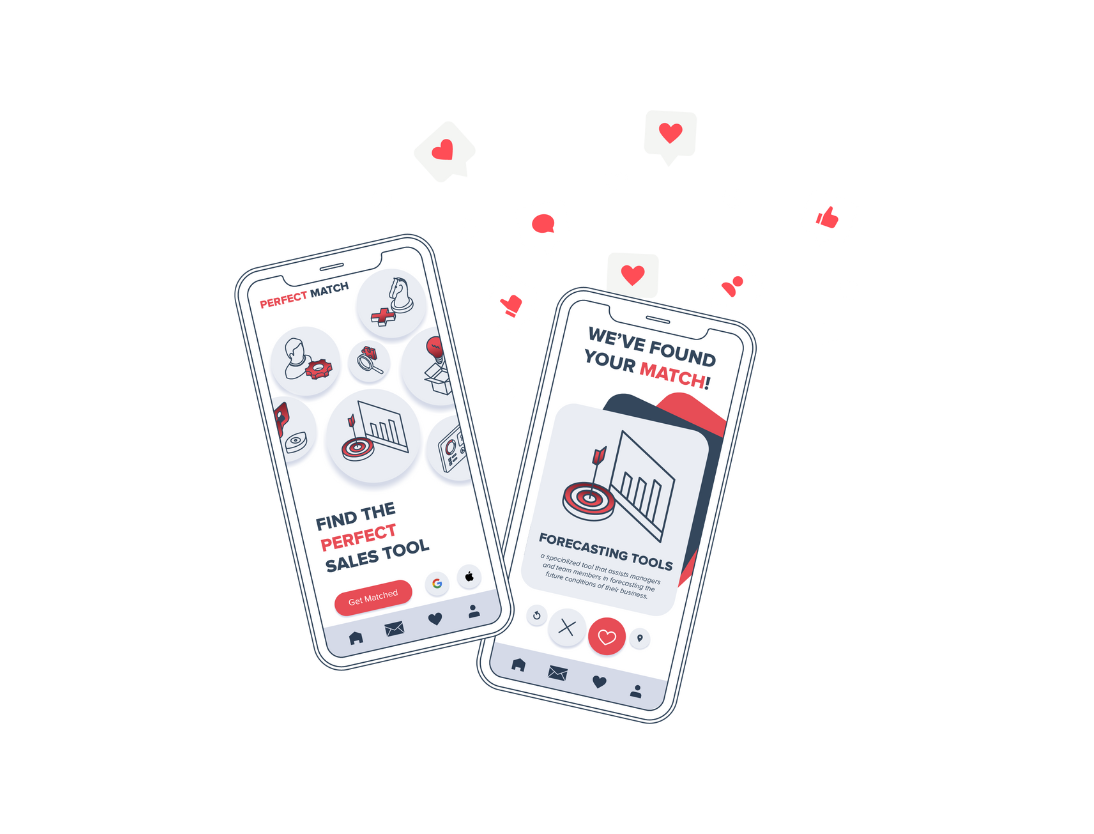In this comprehensive guide, we will explore strategies, best practices, and tools to drive user adoption in HubSpot, ensuring a smooth transition and maximising user engagement.
You've invested in a powerful tool like HubSpot to drive your business forward. But here's the catch: it's only as effective as the people who use it.
User adoption is a critical factor in the success of any HubSpot CRM implementation. While technical aspects such as data migration and system configuration are incredibly important, the true value of the CRM lies in how well users embrace and utilise its capabilities.
In this article, we'll look at overcoming resistance to new technology and measuring user engagement. We'll also explore the strategies, best practices and training you can use to ensure your team successfully adopts HubSpot.
Let’s get started with the impact of HubSpot adoption on your business and the common challenges hindering adoption in HubSpot.
The impact of HubSpot adoption on your business
User adoption and strategies can vary depending on the specific use of HubSpot, whether you use it for marketing, sales or CRM.
Here's how its adoption influences key areas:
- Marketing efficiency: Effective user adoption of HubSpot's Marketing Hub ensures streamlined workflows and centralised data management, optimising campaigns and improving ROI. Without engagement, teams can be faced with disjointed processes that impact the user experience and lead to data inconsistencies.
- Sales effectiveness: Successful user adoption of HubSpot's Sales Hub provides sales teams with valuable insights and automation tools to increase productivity and close deals efficiently. However, a lack of adoption can lead to missed opportunities, scattered data and lower sales performance.
- CRM enhancement: HubSpot's CRM capabilities provide organisations with the ability to seamlessly manage customer relationships. With proper user adoption, companies can leverage data insights to deliver personalised experiences and drive long-term customer loyalty. Conversely, poor adoption can lead to disjointed communication and missed opportunities for customer engagement.
Introducing HubSpot is not just about using a new tool, but about changing your business processes for the better, increasing efficiency and effectiveness and ultimately leading to success.
Common challenges hindering HubSpot user adoption
Avison Young, a full-service real estate service provider, faced the challenge that only 23% of users in multiple locations were using their CRM systems. This decentralised approach led to fragmented processes and data management, which hindered collaboration and transparency of client interactions. The disparate systems created data silos that made it difficult to gain a comprehensive overview of customer relationships and business opportunities.
Recognising the need for a unified CRM solution, Avison Young reached out to Huble to move its teams from four siloed CRMs to HubSpot as its central CRM platform. The transformation was remarkable, with user adoption rising to an impressive 90% in North America, the UK and Europe.
HubSpot's centralised approach streamlined processes, improved collaboration and provided a single view of customer data, overcoming the challenges of fragmented systems and opening up new opportunities for growth and success. Read the full case study here.
But what led to the low user acceptance before and what needs to change? Here are five common challenges that can hinder the user acceptance and adoption of HubSpot:
- Training and education gaps: Without proper training and education, users may struggle to navigate HubSpot's features and functionalities effectively. Investing in comprehensive training programs and resources is crucial to ensure users are equipped with the knowledge and skills they need to maximise the platform's potential.
- Resistance to change: Change can be intimidating, and some team members may resist adopting HubSpot due to fear of the unknown or a preference for familiar processes. Overcoming resistance requires clear communication, demonstrating the benefits of HubSpot, and involving users in the decision-making process to gain their buy-in.
- Data quality and integration challenges: HubSpot's effectiveness relies heavily on the quality and integration of data from various sources. Inadequate data quality or integration can lead to inaccurate insights and hinder decision-making. It's essential to invest time and resources in ensuring data cleanliness and seamless integration to derive maximum value from HubSpot.
- Customisation and user experience limitations: Every organisation has unique needs and workflows, and HubSpot may not always align perfectly with existing processes out of the box. Insufficient customisation options can frustrate users and impede adoption. Investing in customisation and optimising the user experience based on feedback can address these challenges.
- Lack of executive support: Successful HubSpot adoption requires buy-in from leadership to allocate resources, champion the initiative, and drive accountability. Without executive support and leadership, adoption efforts may lack direction and fail to gain traction across the organisation. Securing executive sponsorship and demonstrating the value of HubSpot to organisational goals are critical steps in overcoming this challenge.
Addressing these challenges head-on and implementing strategies to mitigate them will pave the way for successful HubSpot adoption and unlock its full potential within your organisation.
Now, let’s look at effective strategies for HubSpot user adoption.
Effective strategies for HubSpot Adoption in 2024
How can organisations drive effective user adoption among their sales teams when switching to a new CRM like HubSpot?
The right strategies make all the difference.
By tailoring training sessions, creating comprehensive documentation, fostering engagement through webinars and workshops, highlighting the benefits, and providing ongoing support and feedback channels, organisations can empower their teams to fully leverage HubSpot.
Let's explore these strategies in more detail.
Strategy development and implementation
- Create a comprehensive HubSpot adoption strategy: Develop a detailed plan outlining goals, roles, and timelines for HubSpot adoption. First, figure out what you want to achieve. Then, assign roles - like who's in charge of what - and set deadlines to keep everyone on track. Don’t leave it to chance: a proactive approach ensures clarity and accountability and sets the stage for successful implementation and utilisation of HubSpot.
- Establish training priorities: Deciding what to teach first is crucial. Figure out which parts of HubSpot are most important for your team's success and focus on those. By aligning training with what users need and what the organisation aims to achieve, you ensure everyone gets the right skills for the job.
- Pre-plan HubSpot adoption training: Schedule and coordinate training sessions in advance to ensure availability and participation.
- Implement a pilot run: Test the HubSpot adoption strategy with a pilot group before rolling it out organisation-wide to refine and improve its effectiveness.
Training and education
- Personalised training sessions: Sales teams have diverse roles and skill levels, and it is essential to recognise the unique requirements of different team members. For instance, a sales representative may have a different focus compared to a sales leader.
While a sales rep aims to understand how to utilise the tool to effectively close deals, a sales leader's emphasis might be on reporting and activity tracking to drive team performance. By tailoring training sessions to address these specific needs, organisations can ensure that their sales teams are well-equipped to make the most of HubSpot in their respective roles.
- Training champions and management of champions group: Assign a team of experts who can address user queries promptly and provide ongoing support. Their expertise and availability ensure that users receive the assistance they need throughout their HubSpot journey.
- Documentation and resources: Comprehensive documentation, user guides, video tutorials, and FAQs are invaluable resources for sales teams transitioning to HubSpot. These materials should cover a wide range of topics and cater to different learning styles and preferences. Easy access to these resources enables sales teams to quickly reference and apply their learning, accelerating their adoption process.
- Usage analysis and clinics: Regularly analyse HubSpot usage data to identify areas for improvement and offer targeted training clinics to address specific needs or challenges.
User engagement and support
- Engagement through workshops and drop-in clinics: Encourage users to actively participate in workshops and educational resources. These interactive sessions, along with the addition of drop-in clinics, offer valuable insights, best practices, and real-world examples that deepen their understanding of HubSpot's capabilities.
The workshops provide a structured environment for learning, while the drop-in clinics offer a more flexible approach, allowing individuals to seek immediate assistance and ask questions they may have at a specific time on a designated day. Engaging with peers and industry experts in both workshops and drop-in clinics fosters a sense of community, creating a supportive learning environment that inspires sales teams to explore new strategies.
- Feedback channels: Create channels for users to provide feedback, share their experiences, and ask questions. This two-way communication fosters engagement and continuous improvement.
- Continuous onboarding support: Offer ongoing support to ensure users continue to develop their skills and stay up-to-date with HubSpot.
- Offer on-demand, in-app HubSpot training: Provide access to on-demand, in-app training resources for just-in-time learning and troubleshooting.
Community engagement and awareness
- Highlighting benefits: Showcase the benefits of utilising HubSpot effectively. Illustrate how the CRM drives efficiency, improves productivity, and contributes to achieving sales goals. Emphasise how HubSpot's features, such as streamlined lead management, automated workflows, and robust reporting, empower sales teams to close deals faster and drive revenue growth.
Optimisation and automation
- Identify automation opportunities within HubSpot: Explore opportunities to automate repetitive tasks and processes within HubSpot to increase efficiency.
- Implement recognition and reward systems: Recognise and reward users who demonstrate proficiency and drive adoption to foster a culture of continuous improvement.
Performance measurement and improvement
- Measure HubSpot usage and effectiveness: Implement metrics to track HubSpot usage and effectiveness, allowing for ongoing assessment and improvement. Learn more on KPIs and metrics for HubSpot adoption in the section below.
- Monitor HubSpot CRM data quality: Regularly monitor the quality of data within HubSpot CRM to ensure accuracy and reliability.
- Gather end-user feedback regularly: Solicit feedback from end-users to identify areas for improvement and address any issues promptly.
- Track business performance metrics: Monitor business performance metrics related to HubSpot adoption to assess its impact on overall business success.
By following these grouped strategies, organisations can streamline their approach to HubSpot adoption, ensuring comprehensive coverage and effective implementation to drive success in 2024 and beyond.
Key performance indicators (KPIs) and metrics for HubSpot Adoption
Having implemented the right strategies to enhance user adoption, it is essential to measure and analyse the effectiveness of these efforts.
Measuring user adoption provides valuable insights into the success of your HubSpot implementation and helps identify areas that may require additional support or improvement.
By establishing metrics and measurement frameworks, organisations can gain a deeper understanding of user engagement and make data-driven decisions to optimise their user adoption strategies
Let's explore key considerations when measuring user adoption in HubSpot:
1. User adoption rate
Assessing the user adoption rate is crucial for understanding the extent to which HubSpot is being embraced within the organisation. This metric measures the percentage of users actively using HubSpot compared to the total number of users. A high adoption rate indicates successful implementation and engagement, while a low adoption rate may signal challenges that need to be addressed through additional training or support initiatives.
2. Feature adoption rates
Assessing feature adoption rates helps determine how well users are embracing and utilising specific functionalities within HubSpot. By monitoring the usage of various features, you can identify which features are being utilised effectively and which might require further promotion or training. This data enables you to tailor your training and communication efforts to drive adoption of underutilised features and maximise the value users derive from HubSpot.
3. Data quality and accuracy
Metrics such as data completeness, duplication rates, and data entry errors can help organisations assess the quality of data within the platform. Regularly monitoring these metrics allows businesses to identify and address any issues that may compromise data integrity.
4. User feedback and satisfaction
Surveys, feedback mechanisms, or focus groups can be used to collect qualitative and quantitative feedback from users. Analysing user feedback allows organisations to identify pain points, address usability issues, and make enhancements to optimise the user experience.
5. Training effectiveness
Assessing the effectiveness of HubSpot training programs is essential for ensuring that users are equipped with the knowledge and skills they need to succeed with the platform. Metrics such as participation rates, knowledge retention, and skill development among users can be used to evaluate training effectiveness. By tracking these metrics, organisations can identify gaps in training and implement targeted interventions to improve overall proficiency.
6. Time-to-value
Measuring the time it takes for users to derive value from HubSpot after implementation provides insights into the platform's effectiveness in delivering tangible results. A shorter time-to-value indicates successful adoption and ROI realisation, while a longer time-to-value may indicate inefficiencies or challenges in leveraging HubSpot effectively. Monitoring this metric allows organisations to identify opportunities to streamline processes and accelerate value realisation.
7. Mobile adoption for sales teams
Analysing usage of the HubSpot mobile app provides valuable insights, particularly for sales leaders, into how engaged users are with the platform on their mobile devices. High mobile app usage rates mean more flexibility and accessibility, allowing sales reps to stay connected and productive on the go. By closely monitoring mobile usage data, organisations can ensure that the mobile app is effectively meeting the needs of sales teams, seamlessly supporting their workflows and facilitating ongoing collaboration with prospects and customers.
8. User activity levels
Tracking user activity allows you to monitor how frequently users interact with HubSpot. This metric can include the number of logins, the frequency of CRM usage, the creation and completion of tasks, and the overall level of engagement. Analysing user activity provides a clear picture of how actively users are utilising the CRM system and helps identify potential areas where users may need additional support or training.
9. Pipeline and revenue impact
Measuring the impact of HubSpot adoption on pipeline growth, conversion rates, and revenue generation is essential for assessing its effectiveness in driving business outcomes. By correlating HubSpot usage metrics with sales and marketing performance metrics, organisations can determine how effectively the platform is contributing to revenue growth and overall business success. Tracking pipeline and revenue impact metrics allows organisations to make data-driven decisions and optimise their sales and marketing efforts accordingly.
10. Customer satisfaction and retention
By correlating HubSpot usage metrics with customer satisfaction metrics, organisations can identify the impact of the platform on customer loyalty and retention. High levels of customer satisfaction and retention indicate that HubSpot is effectively supporting customer engagement and relationship management efforts.
11. Employee satisfaction
Assessing employee satisfaction levels related to HubSpot adoption is essential for ensuring that users are engaged and motivated to leverage the platform effectively. Surveys, feedback mechanisms, or focus groups can be used to gather insights into employee sentiment and satisfaction levels. By monitoring employee satisfaction levels, organisations can identify opportunities to enhance training, support, and overall user experience with HubSpot.
By tracking these key performance indicators and metrics, organisations can gain valuable insights into the effectiveness of their HubSpot adoption efforts and identify opportunities for optimization and improvement. This data-driven approach enables businesses to maximise the value of HubSpot and drive long-term success.
Let's move from performance tracking to proactive enablement and look at how Hubspot tools and Digital Adoption Platforms (DAPs), like Userlane, are revolutionising the HubSpot adoption process.
HubSpot tools to enhance user adoption
In order to optimise user adoption in HubSpot, the strategic utilisation of tools is key.
Let’s take a closer look at three different options:
- Customised dashboards and reports: Enable users to create personalised dashboards and reports that align with their specific roles and objectives. This empowers users to track key metrics and derive actionable insights.
- Gamification elements: Implement gamification elements within the HubSpot platform to make the user experience enjoyable and engaging. Features such as badges, leaderboards, or challenges motivate users to complete tasks, achieve goals, and foster healthy competition.
- Automation and workflows: Leverage HubSpot's automation capabilities to simplify processes and streamline workflows. By reducing manual effort and automating repetitive tasks, users can focus on more strategic activities.
In conclusion, employing the right tools is instrumental in driving user adoption within HubSpot.
By providing users with the ability to tailor their dashboards and reports, introducing gamification elements to foster enjoyment and motivation, and leveraging automation and workflows for increased efficiency, organisations can create an environment that encourages users to fully embrace HubSpot's capabilities.
Furthermore, ensuring regular communication and updates, gathering valuable user feedback, and offering advanced training sessions and certifications contribute to a user-centric approach that fosters long-term adoption and empowers users to become champions within the organisation.
Digital Adoption Platforms (DAPs) for HubSpot adoption
Digital Adoption Platforms (DAPs) are tools designed to streamline the process of onboarding and training users on complex software systems. By providing interactive, in-app guidance and support, DAPs empower users to quickly become proficient in using software platforms, maximising productivity and efficiency.
Here are key features of Digital Adoption Platforms:
- Seamless onboarding and training: DAPs offer seamless onboarding experiences for new users by providing interactive, step-by-step guides that walk them through essential features and functionalities. These guides are tailored to each user's role and skill level, ensuring a personalised learning experience.
- Contextual support and in-app guidance: With DAPs, users receive contextual support and in-app guidance as they navigate through the software platform. Interactive tooltips and pop-ups offer real-time assistance, providing users with helpful tips, explanations, and best practices right when they need it.
- Task automation and workflow optimisation: DAPs streamline workflows and automate repetitive tasks within the software platform, saving users time and effort. By guiding users through complex processes and automating routine actions, DAPs empower users to work more efficiently and effectively.
- Performance analytics and user insights: DAPs provide comprehensive analytics and insights into user behaviour and performance within the software platform. Organisations can track user engagement, completion rates, and proficiency levels to identify areas for improvement and optimisation.
How Userlane enhances HubSpot adoption
Userlane is one of the leading Digital Adoption Platforms on the market and one of our partners that enables us to provide our customers with the ability to understand and improve how employees adopt and engage with HubSpot, which is required for large-scale CRM migrations and implementations.
Userlane specialises in accelerating the adoption of complex software systems like HubSpot by providing seamless onboarding, contextual support, task automation, and performance analytics.
Here's how Userlane enhances HubSpot adoption:
Content creation: Userlane's Editor facilitates content creation, offering users the ability to generate interactive support materials. With its intuitive features, guides and tooltips can be managed and updated, and users can easily record workflows or customise content with text, images, videos or links. The platform also supports content translation into multiple languages and promotes smooth collaboration through user role management.
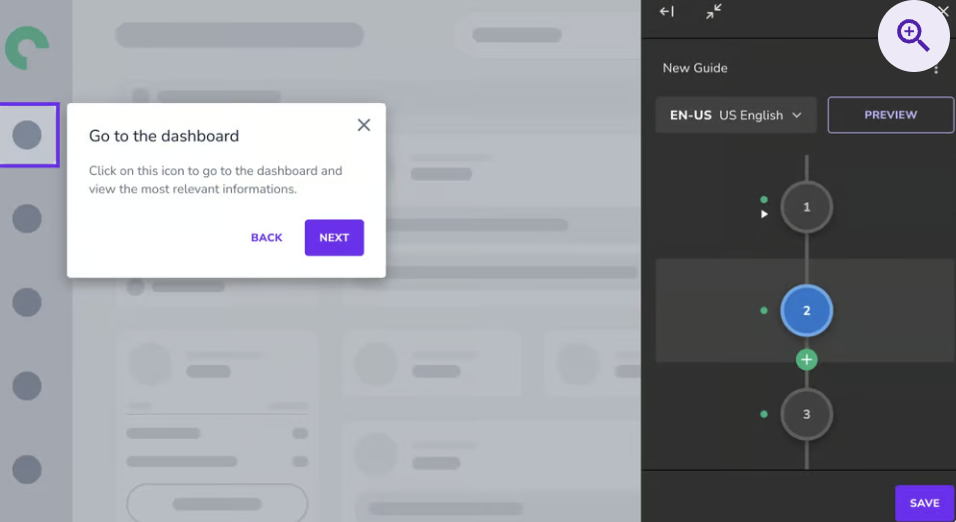
Image source: Userlane
Context-Sensitive Help: From tooltips that provide extra information at the right moment to media-enriched announcements and pop-ups that highlight important features, Userlane ensures users get the help they need exactly when they need it. With AI-driven promotions, you can guide users through key processes seamlessly, boosting their confidence and productivity.
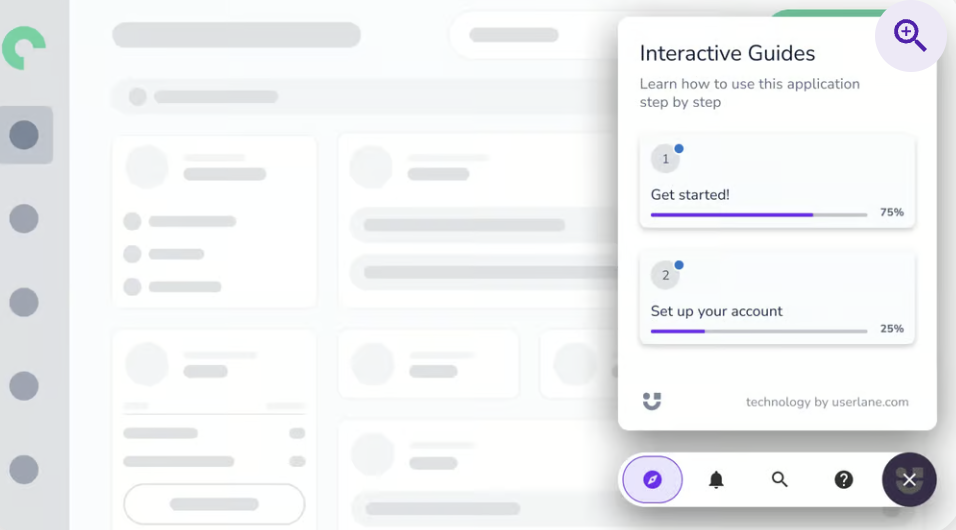
Image source: Userlane
In-App Guidance: Userlane's in-app assistant puts real-time, step-by-step guidance at users' fingertips. Whether they're learning new tasks or navigating complex processes, the assistant is there to support them every step of the way. Users can access customised guides tailored to their needs, ensuring they have the right information at their disposal whenever they need it.

Image source: Userlane
Support Channels Integration: Integrate support channels seamlessly into HubSpot with Userlane. By offering in-app guidance and self-service support options, you can enhance user satisfaction and reduce repetitive support requests. With targeted support through interactive guides and context-sensitive help, users can access the assistance they need without disrupting their workflow.
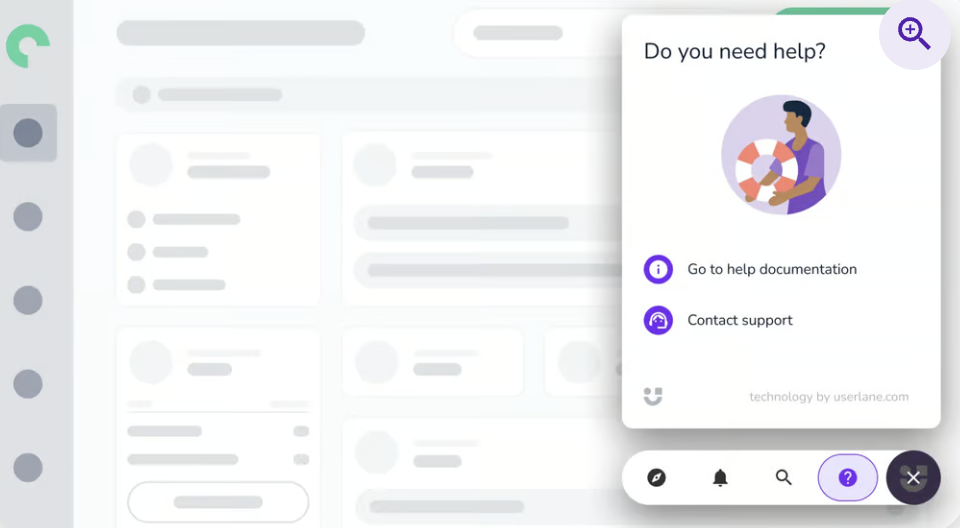
Image source: Userlane
Enterprise Search: With Userlane Enterprise Search, users can access external knowledge bases without leaving the application. By connecting existing support content to the Userlane Assistant, you create a central source of truth that supports users' workflow. With on-demand content tailored to their needs, users can find the help they need quickly and easily, enhancing their productivity and efficiency.
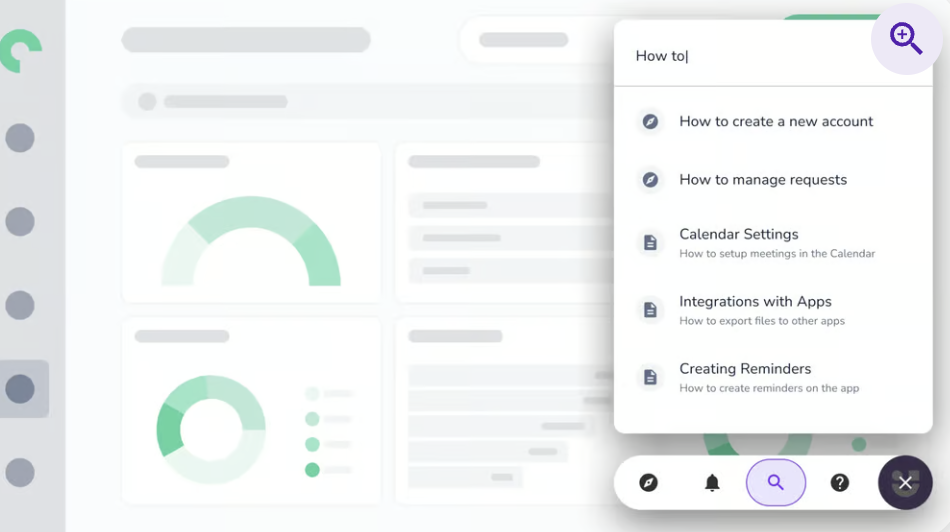
Image source: Userlane
By using digital adoption platforms like Userlane, organisations can increase adoption of HubSpot, improve user experience and unlock the full potential of their CRM.
Ensuring long-term user adoption
User adoption is an ongoing, long-term effort, and it is essential to implement strategies that keep users engaged with HubSpot over time.
Here are some key strategies to help organisations maintain user adoption and maximise the platform's benefits:
- Regular communication and updates: Continuously share information about new features, updates, and improvements to keep users informed and excited about HubSpot. Regular communication ensures that users stay engaged and aware of the platform's evolving capabilities.
- Gather feedback through surveys, interviews, or focus groups: Actively seek input from users to understand their experiences, challenges, and suggestions for improvement. Incorporating user feedback into decision-making processes demonstrates a commitment to meeting user needs and continuously enhancing the platform.
- Incorporate user suggestions into the development roadmap: Value user input by incorporating their suggestions into the future development plans of HubSpot. This collaborative approach makes users feel heard and involved, fostering a sense of ownership and investment in the platform.
- Provide advanced training sessions, webinars, or certifications: Offer opportunities for users to expand their knowledge and skills through advanced training sessions, informative webinars, or certifications. Continuously investing in user education ensures that users stay proficient and up-to-date with HubSpot's advanced features and functionalities.
By implementing these strategies, organisations can ensure that user adoption remains strong and that users continue to derive value from HubSpot in the long term.
The power of HubSpot user adoption for CRM success
Achieving successful HubSpot user adoption is a journey that requires expertise and support. As a trusted HubSpot partner, Huble is well-equipped to guide you through this process.
Our experienced team can provide valuable insights, personalised guidance, and assistance to help you drive user adoption and maximise the benefits of HubSpot.
Contact our team today to learn more and take your user adoption efforts to the next level.







